| May
20, 2006
Hello from Ottawa – A Historic Transportation
Adventure on the Hull-Chelsea-Wakefield Steam Train
Transportation is an integral experience of any trip, and when
you get a chance to experience a unique mode of transportation it's
even better. Even though today we didn't have the best weather,
I drove from Ottawa over the bridge to Hull (now officially part
of the Municipality of Gatineau), and not far from the famous Casino
du
Lac-Leamy is the train station for the Hull-Chelsea
Wakefield Steam Train. This tourist train runs on the former
Gatineau Railway Line, built between 1890 and 1903 by the Ottawa and Gatineau Valley Railway whose purpose was to connect downtown
Ottawa with the Quebec town of Maniwaki in order to facilitate lumber
transports. Due to a shortage of funds the entire railway line was
never fully completed and passenger service through the Gatineau
Valley ceased operation in 1963.
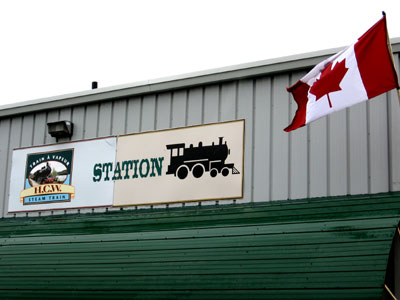
The Hull-Chelsea-Wakefield Steam Train, a glimpse at historic train
travel
Today the 64 km stretch covered by the Hull-Chelsea Wakefield Steam
Train winds its way through a scenic landscape wedged in between
the Gatineau Hills and the Gatineau River. The idea for this tourist
train was conceived by a private and public consortium in 1992,
and in 1994 a local businessman, Mr. Jean Gauthier, bought the tourist
train, restructured the enterprise and turned it into a successful
tourism venture that has since won a variety of prizes and awards,
including several Grand Prizes awarded by Quebec Tourism.
The Hull-Chelsea-Wakefield Steam Train consists of an authentic
steam engine of Swedish origin, built in 1907. Sweden used to have
an entire fleet of steam engines which they phased out in the 1950s
when the country’s railroad system became electrified. They
did not scrap the old steam engines, but put them into storage.
Due to the threat of the Cold War, they feared that their electricity
production capacity might be attacked by invaders, and the old locomotives
were hidden in shelters, just in case they were needed to provide
an alternate source of transportation.
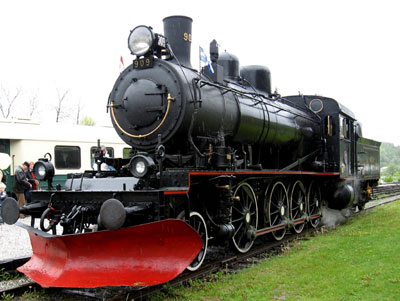
The "909", star of the show at the Hull-Chelsea-Wakefield
Steam Train
By 1990 the threat of the Cold War had subsided and the Swedish
government decided to sell its 200 steam locomotives, one of which
(the “909”) was picked up by the Hull-Chelsea-Wakefield
project along with a 1962 General Motors diesel locomotive. Each
engine is capable of about 1000 horsepowers and when there are more
than 8 coaches attached, usually both locomotives are in service.
The nine coaches themselves were also built in Sweden during the
1940s. The Quebec coach holds a snack bar while the Club Riviera
is the luxury car. The seven other coaches feature comfortable seating
and there is limited wheel chair capacity in the Wakefield coach.
The Riviera car was refurbished and upgraded a few years ago and
features a great room and 3 private rooms. It is often used for
private and corporate events.
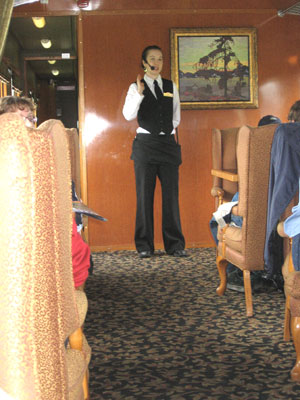
Maxime gives us an introduction in the Club Riviera coach
My ride was going to be in the luxury Club Riviera coach, and as
I settled into a comfortable armchair, I sat back and thought of
the grand old times of train travel. Our tour guide and attendant
Maxime welcomed us through her wireless microphone in both official
languages and our trip had begun. We started rolling slowly through
the north end of Hull and soon Maxime jokingly pointed out a “car
museum” on our right hand side. Turned out it was a junkyard,
I guess “museum” is another, definitely more upbeat
way of looking at it.
Our trusty steam
train pulled us slowly northwards and we moved into a forested
area with the Gatineau River on the right and the forest on the
left. Hundreds of trilliums were blooming in the woods and occasionally
we heard the whistling of the steam engine. Soon after our departure,
Maxime brought an assortment of baked goods, coffee and orange juice
to each table. She explained that the Gatineau River is 400 km long
and has its origin in Northern Quebec. On the right hand side she
pointed out the Chelsea Hydroelectric Dam which was built in 1927
and ended up creating enormous floods. Maxime explained that due
to the dam the river is now 75 to 80 feet deep.
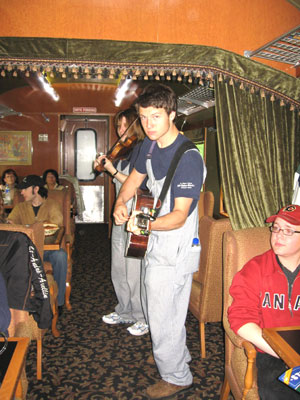
Live music entertained us in the Riviera car
In Tenaga, a native word for “water tank”, trains
used to fill up their water tanks while in Kirk's Ferry, Thomas
Kirk, an American businessman had created a horse-drawn ferry in
the 1850s with horses walking on both sides of the river, pulling
the boats across the river with a pulley system. Once the dam was
built, this became too dangerous and the ferry operation stopped.
Maxime also explained that the train today is propelled by heating
oil, not coal. This was one of the safety requirements imposed by
the Canadian government when they issued the permit for the tourist
train. Heating oil is not only less expensive than coal, it is also
less polluting. We chugged by the Morrison Quarry, a now abandoned
gravel pit featuring a variety of run-down, yet almost picturesque
industrial equipment. On the other side of the quarry is actually
the highest bungee jumping tower in Canada.
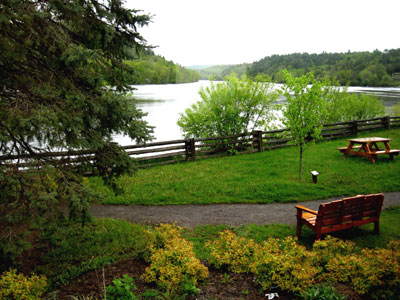
Wakefield is very scenic, even in the rain...
Two young musicians, one with a guitar and one with a fiddle, came
into our railway car and played some folk music which the crowd
greatly appreciated. Every outing on the Hull-Chelsea-Wakefield
Steam Train features an element of live entertainment. In addition
to daytime excursions, the Hull-Chelsea-Wakefield Steam Train also
offers evening excursions featuring a 4-course dinner.
After an hour and a half we finally arrived in the quaint town
of Wakefield, location of many restaurants, tea rooms and souvenir
shops. The big spectacle was yet to come: the operation of the manual
turntable! Once the train reaches its final destination the 93 ton
steam locomotive needs to be turned around for the drive back to
its original location. The engineers slowly drive the train onto
a swiveling circular platform. Then the musicians get to manually
push the platform using lever arms and this turns the locomotive
around in the opposite direction. This is one of only two manual
turntables left in North America.
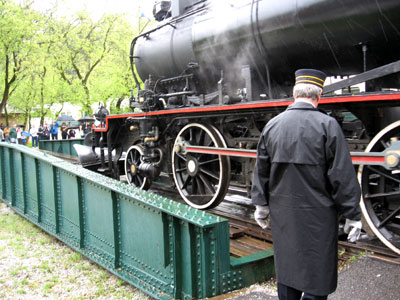
The conductor overseas the turntable operation
A lunch at the Trois Erables Bed and Breakfast was included in
the Riviera Club package, however, I had already made plans earlier
to explore one of the most historic properties in town: the Wakefield
Mill Inn and Spa, a historic gristmill just a 10 minute walk
outside of downtown Wakefield.
Following my discovery of the Wakefield Mill Inn and Spa it was
time to get back on the train at 1:30. There are several sound signals
using the steam whistle to announce the departure of the train back
to Hull and there are 2 departure points inside the town of Wakefield.
People were coming back on the train, somewhat soaked from the rainy
weather, and quite a few of them had obviously been to some of the
crafts shops or chocolate stores around Wakefield.
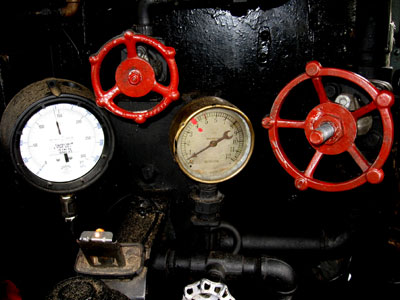
These controls are nearly 100 years old!
It was time for our leisurely hour and a half ride back to Hull,
and the mood in the car was noticeably quieter. The chairs in the
Riviera Car are so comfortable that a few passengers took a little
nap, myself included. The rhythmic chugging of the train is an extremely
relaxing experience and made me doze off a couple of times on the
way back.
Once we had reached our final destination, I experienced a real
treat: the two engineers, Vic and Nikolas, invited me into the cab
of the steam locomotive for a few minutes just before they were
going to turn around the train around for the dinner excursion at
the railway yard. I had missed my turn to climb aboard the engine
in Wakefield, but now I got to catch up and see this mechanical
beauty up close.
Vic himself is a retired RCMP officer who has found the perfect
part-time job. Nikolas, a recent immigrant from Croatia who is very
experienced with steam engines, works on refurbishing and maintaining
the locomotives during the winter time and drives them in the summer.
Both of these gentlemen visibly love their job, they enjoy working
with this close to 100 year old steam engine and take good care
of it to make sure it has many more years of life left.
 |
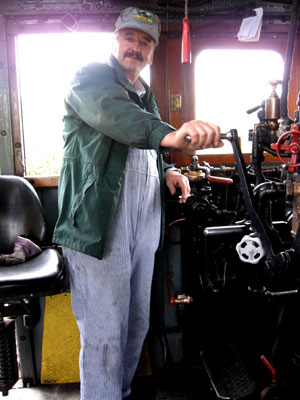 |
| Vic and Nikolas supervise the operation
of the train |
The Hull-Chelsea-Wakefield
Steam Train is a great example of how a historic travel experience
has been revived and become a major local tourist attraction. It
was the perfect way to spend a rainy day.
Related Articles:
Hello from Ottawa
- Overview of my first excursion to Ottawa's Tulip Festival
Hello from Ottawa - Arrival,
two photo exhibitions and my own photo safari
Hello from Ottawa - Doubling up
on antiquity at the Canadian Museum of Civlization
Hello from Ottawa - Sweetgrass Bistro:
Aboriginal dining in the ByWard Market
Hello from Ottawa - The historic
McGee's Inn: 2 couples embark on the adventure of joint B&B
ownership
Hello from Ottawa - The Canadian
Museum of Nature and Fatal Attraction: seduction in the
animal world
Hello from Ottawa - Gatineau Park,
Ottawa's nature playground
Hello from Ottawa - Major's Hill
and a live TV interview
Hello from Ottawa - Bistro 115: Authentic
French-Canadian cuisine in the ByWard Market
Hello from Ottawa - Historic transportation
on the Hull-Chelsea-Wakefield Steam Train
Hello from Ottawa - The Wakefield
Mill Inn & Spa: from historic gristmill to upscale lodging,
dining and pampering
Hello from Ottawa - Flower
and dress design at the Casino du Lac-Leamy
Hello from Ottawa - The Flotilla
- a parade of decorated boats - and an interview about the background
of the Tulip Festival
Hello from Ottawa - Sheep shearing
at the Canadian Agriculture Museum
Hello from Ottawa - Tractors,
cows and small animals at the Canadian Agriculture Museum
Hello from Ottawa - My 2-day
packed itinerary for Winterlude
Hello from Ottawa - First
impressions and an overview
Hello from Ottawa - The Lord Elgin
Hotel: a historic landmark in the heart of Ottawa
Hello from Ottawa - Fat Tuesday's
and the Mardi Gras Experience in the ByWard Market
Hello from Ottawa - An early
morning walk to Parliament Hill
Hello from Ottawa - Skating
on the Rideau Canal, the World's Largest Skating Rink
Hello from Ottawa - Charity and
hilarity: the 26th Annual Bedzz Races on Dow's Lake
Hello from Ottawa - Confederation
Park and other Winterlude locations
Hello from Ottawa - Darcy McGee's:
a historic Irish pub on Sparks Street
Hello from Ottawa - The Canadian
War Museum and "Weapons of Mass Dissemination - The Propaganda
of War"
Hello from Ottawa - The
Canadian Museum of Contemporary Photography featuring Sunil Gupta
and the challenges of immigration
An interview with Tourism Ottawa
provides a great overview of this city
An interview about
the ByWard Market, a prime entertainment and shopping area
An interview
with the National Gallery of Canada
An interview
with the Canadian Museum of Civilization
Helpful websites:
Ottawa
Tourism: Ottawa's official tourism information
The ByWard
Market Business Improvement Area
The
National Capital Commission
The National
Museum of Civilization
The National Gallery
of Canada
The Canadian War
Museum
The Canadian Museum
of Nature
The
Canadian Agriculture Museum
Useful books about Ottawa:
|